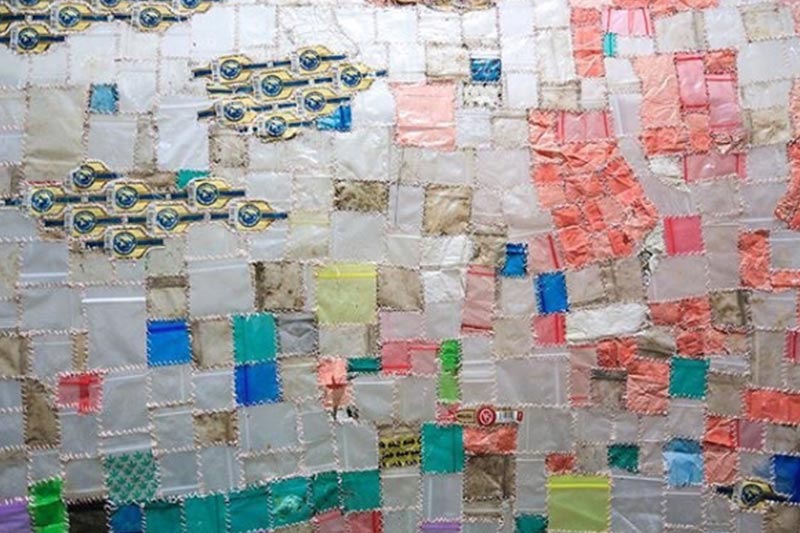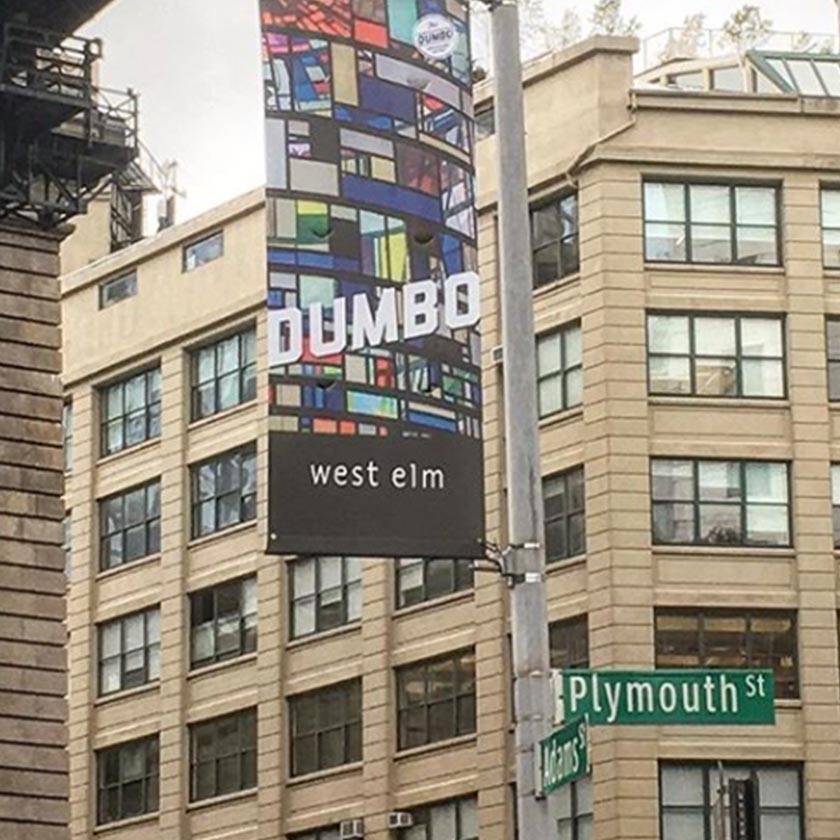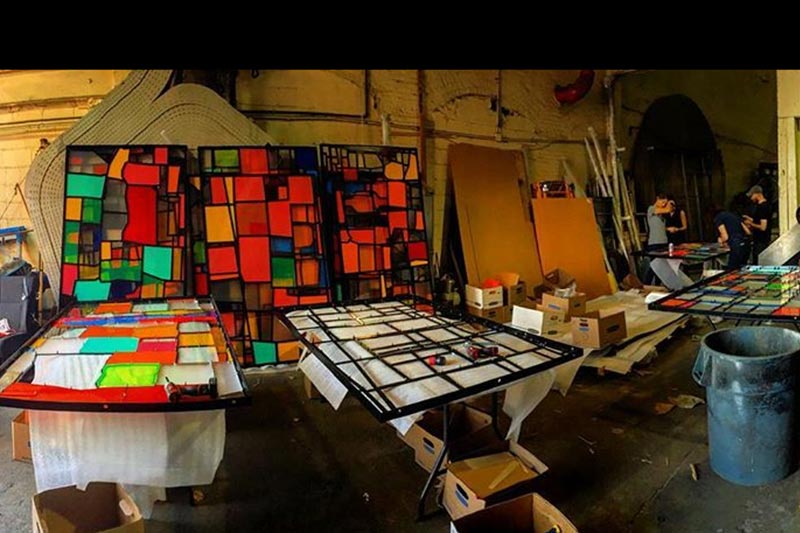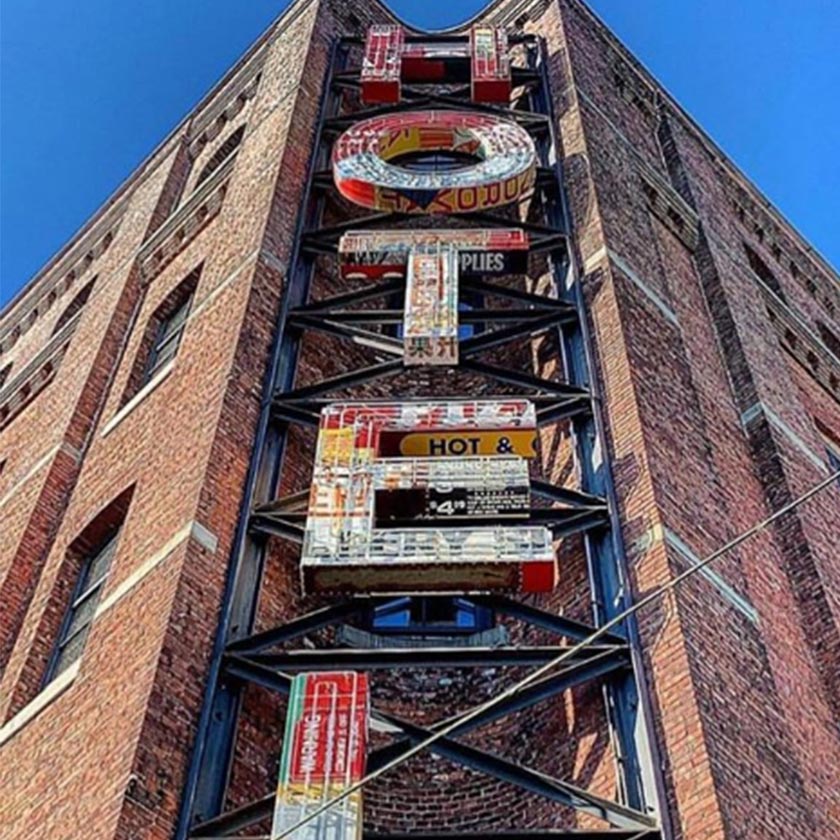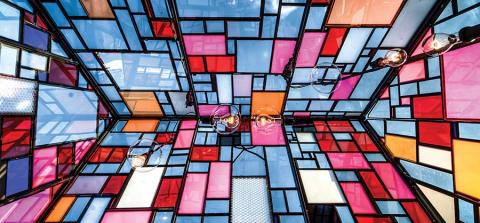
Sculptor Tom Fruin ’96 has fashioned a colorful patchwork of found objects into symbols of his city and international acclaim as an artist.
By Andy Levinsky.
Tom Fruin wants to take you for a ride. A California native, Fruin moved to Manhattan almost immediately after graduating from University of California, Santa Barbara in 1996. The following year, he moved to Brooklyn which has been his home ever since. Your tour will be focused on the neighborhood of Dumbo, an acronym for “Down Under the Manhattan Bridge Overpass” which, according to dumbonyc.com, “was conceived by resident artists as a way to make the area sound silly and unattractive to people looking to buy real estate here.” This was in 1978, before the borough’s metamorphosis from gritty city to hipster haven.
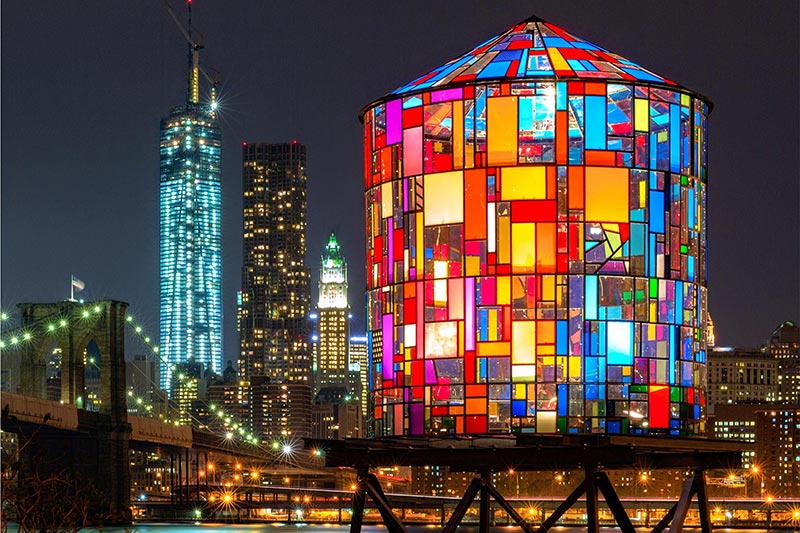
The Watertower, Brooklyn Bridge Park. Photo: Matt Pugliese.
A E Smith: Shattered, 2009. Found drug bags, pink thread. 26 x 34 in
mounts: threaded rod, magnets, rubber. Photo: Tom Fruin.
When Fruin arrived in 1996, he began collecting drug bags and other litter, first from his stoop, then from other neighborhoods each of which, he noticed, had its own distinctive debris. Recycling the trash into quilts was, he recalls, “meant to be a faux smart idea of taking this disreputable material and turning it on its ear and making some classic American symbol of warmth and family and security and home.” Initially, Fruin thought “it was going to be really abject and dirty and it ended up being very alluring and beautiful. People responded to it right away.” In 2002, Fruin, then 27, sold almost all of the quilts at his second solo show, “Cultural Narcotics: The Straight Dope.” One was purchased by the actor Willem Dafoe for $30,000. Fruin was becoming something of a celebrity in the art world but his focus remained steadfastly on his work. The way the quilts were hung from metal rods extending out from the wall evoked the feel of stained-glass. As he told The New York Times, “The light going through it completes it for me.”
The first stop on Fruin’s tour “commands your view as you’re driving on the BQE (Brooklyn-Queens Expressway) which,” he notes, “is why I chose that location. It’s derived from a found object quilt that I made from nearby housing projects,” but it is a 25-foot solar powered water tower. Why a water tower? Fruin’s wife Becky, an archivist, once asked him, “‘What would your icon be for New York’ and I said a water tower right off the bat and she said, ‘Fantastic. Let’s do that.’”
This water tower is perched on a building that’s roughly a century old. “You first see the Brooklyn Bridge in front of you, then the water tower appears and then you have to kind of turn your car so the water tower folds across the skyline and positions itself as you pass it to be on par with all the lower Manhattan buildings,” he explains.
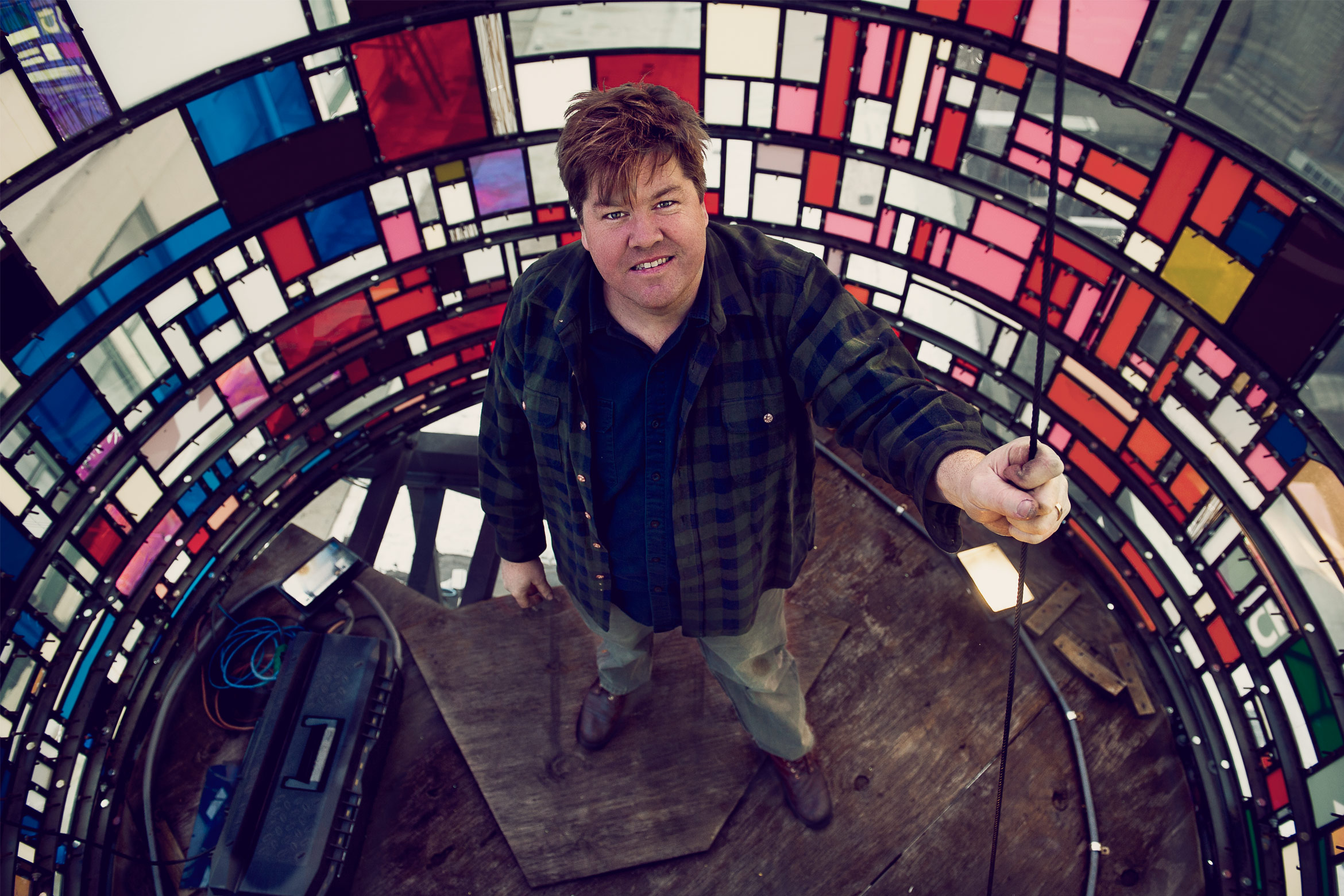
Fruin inside the Water tower. Photo: Guerin Blask.
Fruin has an active presence on Instagram and his work is generously represented on YouTube and throughout social media, yet it’s easy to understand why he wants visitors to experience it for themselves. There are so many details like the way the solar panels, which have been absorbing light all day, provide an hour-long sequence “that gives it a little dance.” Initially, Fruin was concerned that some commuters might miss some “sublime moment of their commute.” Instead, it turns out to have provided one in that “It’s kind of a respite from their drive to see this thing kind of miraculously appear.”
Banner in Dumbo Brooklyn.
Photo: Tom Fruin.
Fruin’s work tends to attract passionate, personal reactions. Visiting Brooklyn this spring, UCSB Assistant Vice Chancellor George Thurlow BA ’73 stopped by Kolonihavehus, a garden house Fruin created in 2010 from a thousand scraps of recycled plexiglass and steel. Thurlow found “a wedding photographer posing newlyweds inside for a series of romantic poses. The groom explained that they chose this place for photos because it was where they had come on their first date.”
In May, Fruin brought a house structure called Maxikiosco for a spring residency at the plaza of Empire Stores, a retail, office and event space that has become a signature of the new Brooklyn since it opened in 2017. “The legend himself will be placing one of his iconic pieces in our courtyard,” the Empire website reads, encouraging visitors to “come take a photo inside of Tom Fruin’s installation.” The invitation was unnecessary. “If I stand there for more than five minutes,” Fruin notes, “there’s like 20 people taking selfies with it and posting them online.” He gets emails “from people saying ‘I discovered your work in a really dark moment taking the subway home over Manhattan bridge and it became very special to me. Since then, I’ve shared it with my girlfriend or boyfriend and now I’d love to propose. This is such a meaningful thing to both of us that I’m wondering if I could have roof access to come up there and surprise my partner by proposing with that as a backdrop.’ I’ve gotten about 20 emails like that and when I can, I’ve done it.”
Though Fruin’s work has been exhibited across the U.S. and internationally from Austria and Argentina to South Korea and Switzerland, it has become synonymous with Brooklyn.
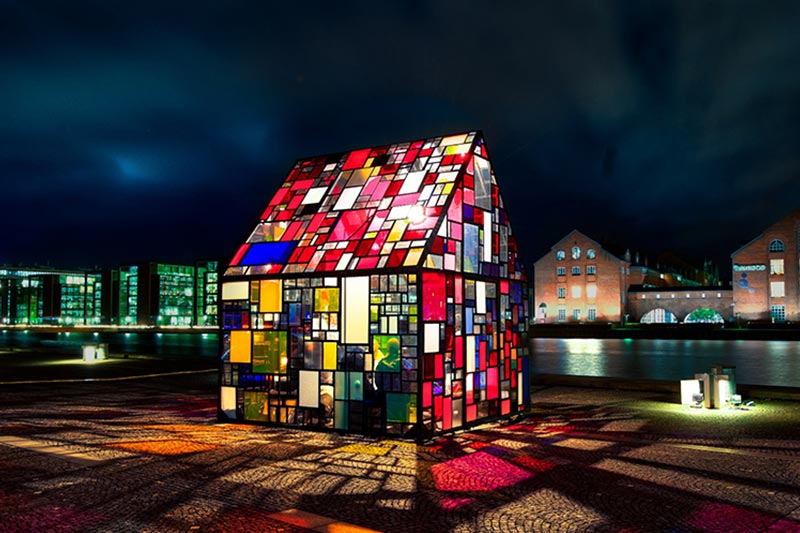
Kolonihavehus at night. Photo: Andreas Steen.
“I can’t recall the first time I knew Tom’s work because it seems like it’s been part of Brooklyn, either on the skyline or in public spaces for a very long time,” says Charlotte A. Cohen, Executive Director of the Brooklyn Arts Council.
While Fruin has spent much of his adult life and his career living and working in Brooklyn, his work has only been a part of its fabric for a relatively short period. Perhaps its iconic status has been amplified by the transformation that has been taking place during that time. When Fruin arrived, Brooklyn had a wrong-side-of-the tracks reputation. Today, “Brooklyndia” is a mecca not only for artists but for the young, old, even families (Fruin and his wife have two young children).
The Workshop. Photo: Matt Canada.
Fruin sees a clear connection between the drug-bag quilts early on and the Icon series, as the stained-glass structures that have become his signature are known. Both, he points out, use quilting techniques to recycle found objects. Yet it also may be easier to find recycled bags for J. Crew or West Elm than it is for drugs in Dumbo today. In a way, Fruin’s work documents the changes in the neighborhood.
“I wouldn’t say I had anything to do with the rapid mass gentrification of Brooklyn,” he says, “but was maybe more a part of it.”
If you ask people outside of New York for an emblem of Brooklyn, most would probably name the Bridge. In the borough, however, Fruin’s water towers have become sort of de facto “people’s” landmarks. Cohen says that “He makes us notice something we ‘see’ every day but don’t necessarily register in our consciousness as an icon of our city.”
If I were a sculptor (but then again...)
Growing up in Manhattan Beach, California, Fruin was surrounded by art, including murals in his bedroom painted by his mother, a social worker-turned-homemaker. “We had original art on the walls and a very encouraging artistic environment,” he recalls. “My brother was very into coding and early computers and I mostly drew pictures. My brother inspired me to make my first sculptures using telephone wire from the repair man at the top of the street.”
Along with his father, (a patent attorney who became a California Superior Court judge), his mother and older brother, Fruin went to exhibitions at LACMA (Los Angeles County Museum of Art), MOCA (Museum of Contemporary Art) and its predecessor, The Temporary Contemporary.
Every weekend, he would ride his bike to Venice Beach to buy music and underground comics by legendary artists like Rick Griffin and R. Crumb.
“Mostly, I was there watching it all go down,” he recalls. “Mainly street performers and the scene at Muscle Beach. I used to tempt my nerves riding up Ballona Creek, taking pictures of graffiti in the storm drain tunnels. When I got older, I found there were a bunch of galleries there and I would check them out.” He recalls “Helter Skelter: L.A. Art in the 1990s” at MOCA as “eye opening.”
Yet when it was time to look at colleges, Fruin says, “I just didn’t think my parents would really support my idea of an institution to study art.” Plus, he says, “I think I realized that college was meant to give me some life experience, so I wanted to go to a big school that had a little of everything...I was happy for the wide diversity Santa Barbara had to offer from straight-edge punk to fraternity houses. I wanted to have it all and SB did not disappoint!”
Fruin initially majored in psychology but took art courses as well. He recalls even some freshmen art classes as being “like my introduction to a more serious art community.”
One member of that community, Jason Rogenes MFA ‘96, a teaching assistant, was impressed by “his willingness to go the extra mile for great work” and “would rely on him to keep class discussions going.” A fellow student, Matthew Heller BA ’96, recalls “scavenging the city for discarded materials” with Fruin to collaborate on sculptural installations.
The most influential part of Fruin’s community was the sculptor Kim Yasuda, a professor of Public Practice in UCSB’s art department. “Of the more than a thousand students I’ve taught in nearly 30 years, Tom remains a standout,” Yasuda says. He was “creating evocative, complex works that made you think deeply about the world and your place in it.”
When they caught up by phone in May, it was clear that the instructor and the student expanded each other’s horizons.
“I always remember you having a refreshing wavelength,” Fruin says. “Mostly that art didn’t have to be made of clay or paint; it could be anything or nothing. Your assignments of physically representing absence were especially eye-opening for me.”
“I remember a self-portrait project where he vacuumed his room and meticulously cataloged the contents of the vacuum cleaner bag as a forensic document of his embodied and shredded life,” says Yasuda.
"He was not going to follow. He would lead us all to explore new and existing frontiers across our campus as he continues to do.” -Kim Yasuda, Professor of UCSB Art Department
“I vacuumed my room ten times and organized the contents into Ziplocked bags [arranged] on the wall like a CSI episode each labeled:“ fingernail clippings 12,” “hair (not mine),” “matchstick (burned), etc.,” Fruin recalls. “Maybe a harbinger for drug bag flags in NYC?”
“We both agree that this piece foregrounded his early work out of school when he moved to NYC,” Yasuda adds.
She says “it was because of Tom that my own instructor policy for non-arts majors changed and in subsequent sculpture courses, I began admitting students from across the campus to join the class, regardless of their limited background or training in art.”
Yasuda also remembers “when Tom expanded his circle to include work with students in other departments, such as theater and dance. He was not going to follow. He would lead us all to explore new and existing frontiers across our campus as he continues to do.”
Ultimately, Fruin graduated not with the degree he anticipated in psychology but one in studio art. “It always struck me that his training and background in psychology informed his work in ways that were not as critically developed in most undergraduate majors,” Yasuda adds, “including art.”
A Stitch in Time
If anyone knows Brooklyn, it’s Jed Walentas. As the CEO of Two Trees Management, Walentas runs the real estate development company that was largely responsible for the transformation of DUMBO from an industrial wasteland to a destination neighborhood. And, if there is anyone who knows Tom Fruin, it is Walentas. They first met in 1997 when an arts organization Fruin was part of moved to Dumbo. When Fruin came up with the idea for the first water tower, he recalls, “I approached my landlord who owns most of Dumbo about the concept and he said, ‘Yeah, do whatever you want. Let me know what building you like and I’ll help you out with it.” Walentas even had his staff help with permitting and logistics.
The Wythe Hotel. Photo: Guerin Blask.
“Tom is someone I had tremendous confidence in and wanted to see him succeed,” Walentas explains. He has one of Fruin’s drug bag quilts in his home, and features a Fruin project on the Two Trees website. Walentas even hired the artist to create a sign for his hotel, The Wythe, which Fruin made from neon wrapped in old tin advertising signage he had collected over the years.
“I’ve seen arc and trajectory of his career,” he adds, and “I think the water towers are fabulous.”
Yet when Walentas thinks of icons for Brooklyn, it is high profile landmarks like the Barclay’s Center and the Williamsburg Savings Bank Tower that come mind.
“I see [Fruin’s] water tower as more a part of the fabric or the quilt for these neighborhoods than a singular icon,” Walentas says.
Compared with the Williamsburg Savings Bank Tower, that has been on the skyline since 1929 (and was once the tallest building in the borough), and the Barclays Center, home of the New York Islanders and Brooklyn Nets, it’s hard to disagree.
But as Walentas points out, “Even in these times of change...we’re still putting water towers on a lot of these new buildings.” In his signature water towers, Fruin stitches together old and new to create a symbol for the city and the borough.
“While the water tower sculptures are monuments to the architectural forms of NYC, their presence in Brooklyn seems natural,” observes the Brooklyn Arts Council’s Charlotte Cohen. “They are like beacons looking out over the East River.”
The fact that they have been discovered largely through word-of-mouth makes Fruin’s work a particularly apt symbol for a D.I.Y. borough like Brooklyn. “When we came upon this concept of the icon series, I started to imagine what some fantastic icons would be for other cities,” he says. “In order to do a full smokestack in Detroit, for instance, it would be very expensive.” Acknowledging that his concepts can be “more concept-driven than reality-checked,” Fruin adds, “Every couple of months, I probably have another totally outlandish idea...and they get more outlandish as I go on.”
